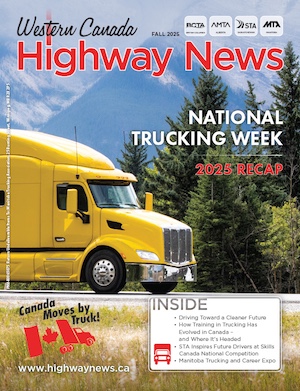Honouring the Past, Celebrating the Present, and Embracing the Future
This year as we reflect on our industry, one thing we know for certain is that our love for trucking has never been stronger. These past 12 months have brought new challenges that we have never faced before, yet truck drivers continued to deliver as they always have for the last hundred years.
Ten years ago, the BC Trucking Association funded the illustrated history of Trucking in British Columbia to commemorate a century of trucking. Through vignettes, stories, and photos, award-winning author Daniel Francis chronicles the stories of the women and men who have belonged to an industry that helped shape BC’s past and continues to touch each British Columbian daily. To celebrate the book’s tenth anniversary and honour National Trucking Week 2022, we are looking back on how one of BC’s five largest industries began.
Trailblazing Truck Drivers
From the first horseless carriage to a $2 billion industry with over 60,000 trucks on our province’s roads today, BC’s trucking industry has experienced considerable change over the past century. What has not changed is the fact that trucking remains a critical link for all other modes of transportation, and without commercial truck drivers, our economy would collapse.
Over one hundred years ago, truck drivers arduously forged new routes and paved the way for the intricate network of highways and roads that we currently drive on. Navigating the once rugged dirt and gravel paths, early trucks travelled at a top speed of 20 kilometres per hour, taking up to four days to travel from Vancouver to the Okanagan. However, these drivers persevered; they linked communities and towns throughout BC and delivered the freight they depended on, with only one to three tons per load.
Along with having to brave challenging infrastructure, the early days of trucking were incredibly physically demanding on the driver. A combination of BC’s difficult geography with its varied terrain and the limits of technology meant trips were long. With no power steering, little suspension, and no heating and defrosting in cabs, drivers had no choice but to be resourceful to stay safe and comfortable. Often, they would wedge a piece of wood under the hood to keep it partly open so that heat from the engine would keep the windshield frost-free. The men and women who transported freight across the province knew that a long-haul career involved more than simply driving. Not only did drivers have to be their own mechanics (as there was no one to come if a truck broke down), but they would also have to load and unload freight manually.
Although they were in competition with each other, drivers worked together to overcome the many challenges they faced. In many sections in the interior, the roads were so narrow that two trucks could not pass. One would have to back up to the nearest pullout to allow the other to go by. Truck drivers would also stop to offer help or give a tow to the nearest town when they would come across a broken-down truck, understanding the dangers and discomforts that were a part of their job.
Trucking of Today & Tomorrow
Fast forward to today, the industry has come a long way with extensive advancements made in infrastructure, equipment, technology, and regulation. These remarkable developments best illustrate the direction of our industry’s transformation – leaner, cleaner, quicker, and safer. All the way back to 1932, when 162 public freight licences were issued to over 26,000 registered BC carriers today, the camaraderie that existed in the early days of commercial driving remains today. Nothing has demonstrated this more than the devastation BC experienced in 2021. From the fires that ravaged the interior to the floods that destroyed communities and major inland routes and ripped our province in half, our industry came together to swiftly devise innovative ways to overcome obstacles. Drivers performed the near impossible and incredibly dangerous work to deliver goods where they were needed most, ensuring all British Columbians had access to the essentials.
As we head into the second century of trucking in BC, the need for improved transportation – especially more trucks – will only grow. BCTA will continue to contend with the issue of growth and explore new and efficient methods of recruitment, as well as identifying best practices and mitigating strategies that address driver shortage causes. Trucking is vital to our economy, and the contribution that truck drivers and those in the commercial transportation industry have made to the growth and unification of British Columbia is nothing less than remarkable. We thank them for their daily commitment to their work because, without them, we would not be enjoying the quality of life we have today.
To learn more about the history of trucking in BC, pick up a copy of Trucking in British Columbia by Daniel Francis.
References
Francis, D. (2012). Trucking in British Columbia: An Illustrated History. Harbour Publishing Co. Ltd.
1 Transport Canada, Transportation in Canada 2019: Statistics Addendum. Table EC4, 2019
2 Statistics Canada, Vehicle registrations, by type of vehicle, 2009-2019. Table: 23-10-0067-01
3 Ministry of Transportation and Infrastructure, 2019 National Safety Code data
4 WorkSafeBC data: www.worksafebc.com


 1-866-985-9791
1-866-985-9791



